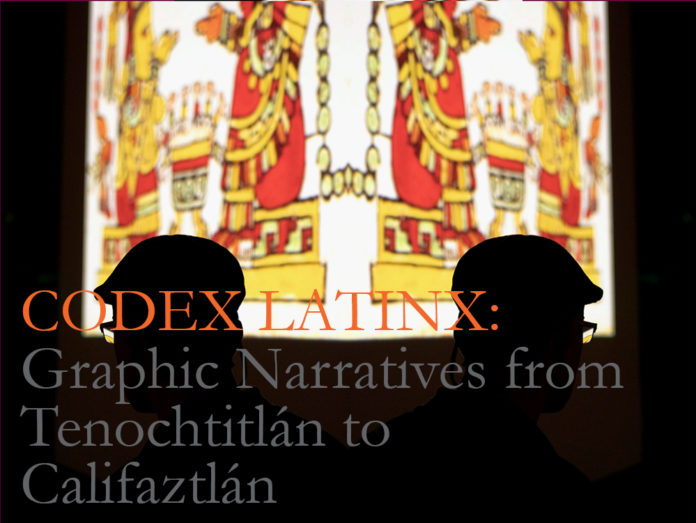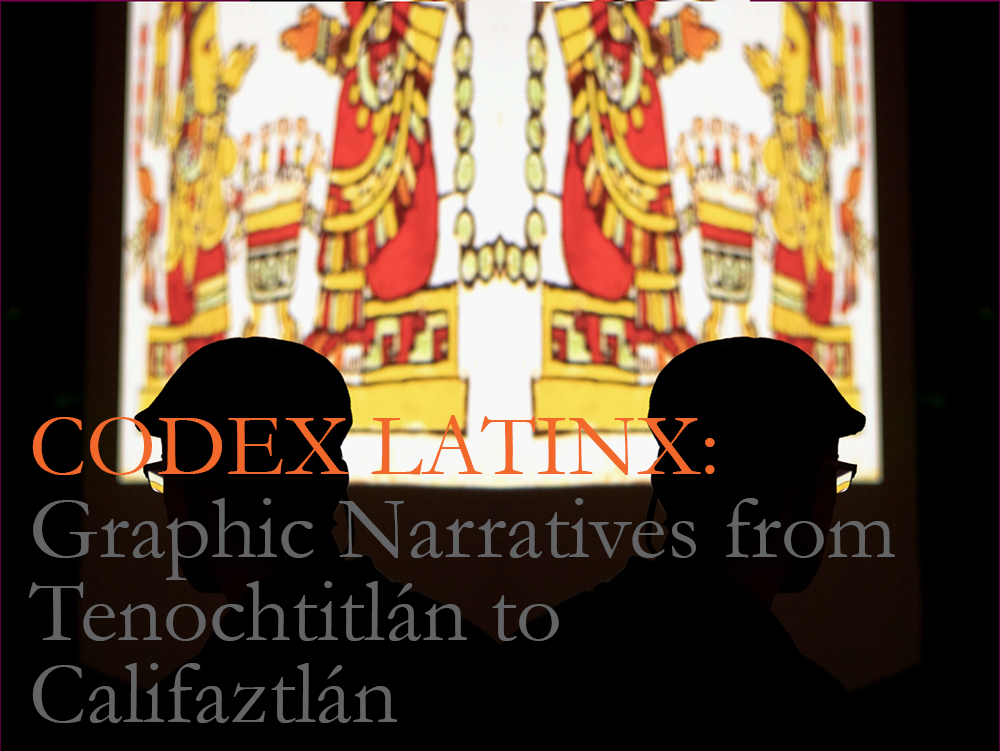
Professor Lisa Sousa from the Latino/a and Latin American Studies Department hosted artist Sandy Rodriguez and poet Adolfo Guzman-Lopez for “Codex Latinx,” an art display inspired by Aztec culture. The event was for Cultural Studies Program (CSP) 99: Experiencing the Arts. “Codex Latinx” took place in Choi Auditorium March 5 and drew a large audience of students and professors.

Sousa began the event by introducing the Aztec art of codices. Codices, according to Sousa, tell stories through multiple images composed of paint and a type of paper called amate that is exclusively made in Mesoamerica. During the Spanish conquest, Spaniards banned the production of amate paper, which gives it a modern cultural significance of resistance beyond its distinct aesthetic, according to Rodriguez and Guzman-Lopez.
Before Rodriguez showed her art, Sousa called up 10 volunteers to hold an intricate codex that spanned the length of Choi Auditorium. After Sousa laid out the foundation and history of Aztec codex art, Rodriguez began the main portion of the lecture, presenting a PowerPoint with photos of her paintings that, in their original form, measure up to ten feet by ten feet.
According to Rodriguez, color in this art is important not only because it breathes life into the landscapes she paints, but because there is an esoteric meaning based on where the colors come from. For example, according to Rodriguez, red signifies that something is related to the earth because the physical pigment comes from the ground. Using strategies that would have been used in the time of the Aztec Empire (1320–1522), Rodriguez personally hand-processes the colors she uses in her work.
“There is a sort of codification of how we read color,” Rodriguez said. “Where paint comes from and the color affects the meaning.”
In the corner of one of her paintings, “Mapa de la Región Fronteriza de Alta y Baja Califas,” Rodriguez depicted herself going through the process of making paint in the way Aztec people would have.
Alejandra Herrera (first year), who attended the event, said that she found this notion intriguing.
“I thought it was really interesting how she incorporated Aztec colors into her art and how she derived them in the same way they would,” Herrera said.
Because much of her artwork is based on maps, an audience member inquired about which maps she used for inspiration. Her response revealed she analyzes a wide variety of maps including a combination of colonial, contemporary and 19th-century printed maps.
After speaking about her traditional methods of creating art, Rodriguez said she seeks to inject modern social commentary into her work.
Rodriguez grew up in Southern California and Tijuana, Mexico. She said she built her heritage into her art by employing various cultural and historical techniques. This entails finding the colors in the environment in which they naturally occur and grinding the pigments. With this, she creates paintings that not only contain landscapes but also reveal a deeper social commentary.
In one of her paintings displayed in the slideshow, “De Las Señales Prognosticos I.C.E Raids en el Sanctuary State de Califas,” Rodriguez depicts people being arrested by U.S. Immigration and Customs Enforcement (ICE) agents.
“There’s these moments of resistance you’ll see throughout the art,” Rodriguez said.
Rodriguez said she painted what would be relevant in the lives of Mexican immigrants. In one of her paintings depicting the West Coast, predominantly California, she painted fires where immigrant detention centers were stationed.
After Rodriguez spoke, poet and journalist Adolfo Guzman-Lopez followed with his poetry that was inspired by the methods Rodriguez used to create her paintings.
Guzman-Lopez found a synthesis of faith and culture between Judaism and Aztec culture. Before beginning his poetry, he mentioned how Sousa having students hold the long codex reminded him of how he understood the Torah in his Jewish faith: unraveled before him.
“It is through Judaism that I’m understanding Tenochtitlan culture,” Guzman-Lopez said.
Together, Rodriguez and Guzman-Lopez collaborate to create workshops in Rodriguez’s studio about Aztec culture, combining poetry and visual art.
Sousa spoke to how important it is for indigenous people to reclaim their culture because the Spanish translation of codex leaves out important factors that were both harmful and formative in the lives of indigenous people.
“The Spanish translation omits the atrocities the Spanish committed,” Sousa said.
In one of Guzman-Lopez’s poems from October 2017, he summarized the mission of Rodriguez’s art and the purpose of using traditional methods.
“The lesson is that our founding documents are not static and limited. They have infinite space in which we can update the stories with our own. Go out, come back, and write and draw your own version,” Guzman-Lopez wrote.
Rodriguez will have exhibitions this fall at Riverside Art Museum, the Los Angeles Municipal Art Gallery and the Performing Arts Center of Los Angeles County.
![]()


































